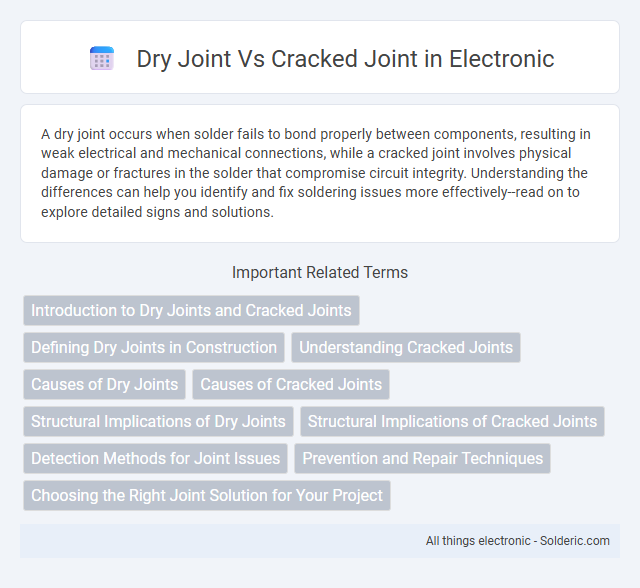A dry joint occurs when solder fails to bond properly between components, resulting in weak electrical and mechanical connections, while a cracked joint involves physical damage or fractures in the solder that compromise circuit integrity. Understanding the differences can help you identify and fix soldering issues more effectively--read on to explore detailed signs and solutions.
Comparison Table
| Feature | Dry Joint | Cracked Joint |
|---|---|---|
| Definition | A joint between materials without any bonding agent or sealant. | A joint showing fractures or breaks in the bonding area. |
| Appearance | Clean, gap without visible damage. | Visible cracks, splits, or gaps with irregular edges. |
| Structural Integrity | Typically weaker due to lack of adhesion. | Compromised; risk of failure increases with crack severity. |
| Causes | Absence of bonding material or inadequate assembly. | Stress, material fatigue, thermal expansion, or poor curing. |
| Water & Air Tightness | Poor; susceptible to leaks. | Generally poor; cracks allow infiltration. |
| Repair | Application of sealant, adhesive, or proper bonding method. | Crack filling, reinforcement, or joint replacement. |
| Applications | Used where flexibility or movement is needed but bonding is minimal. | Unintended; indicator of damage needing fix. |
Introduction to Dry Joints and Cracked Joints
Dry joints occur when a concrete section lacks proper bonding between layers, often due to inadequate curing or delayed pouring, leading to weak structural integrity. Cracked joints result from stress factors such as thermal expansion, shrinkage, or excessive loading, causing fractures that compromise durability and safety. Understanding these defects is crucial for effective repair strategies and maintaining long-term infrastructure performance.
Defining Dry Joints in Construction
Dry joints in construction refer to connections between building components where no mortar, grout, or adhesive is applied, relying solely on mechanical interlocking or friction for stability. These joints are typically found in precast concrete segments, masonry units, or timber structures where movement accommodation and ease of assembly are prioritized. In contrast, cracked joints indicate structural failures where material fractures compromise integrity and may require repair or reinforcement to restore performance.
Understanding Cracked Joints
Cracked joints occur when the concrete or mortar experiences stress beyond its capacity, leading to visible fractures that compromise structural integrity and waterproofing. Unlike dry joints, which are intentional separations to accommodate movement, cracked joints indicate damage from shrinkage, thermal expansion, or load stress. You should address cracked joints promptly to prevent further deterioration and maintain the durability of your construction.
Causes of Dry Joints
Dry joints occur when solder fails to properly wet the surfaces of the components and PCB pads during the soldering process, often due to insufficient heat, contaminated surfaces, or expired solder paste. Poor flux activity or improper reflow profiles can also lead to incomplete melting, resulting in weak mechanical and electrical connections. In contrast, cracked joints typically arise from mechanical stress, thermal cycling, or improper handling after soldering.
Causes of Cracked Joints
Cracked joints are primarily caused by excessive stress, thermal expansion, or material shrinkage that exceeds the joint's tolerance, leading to fractures. Poor joint design, improper curing, and environmental factors such as moisture fluctuations also contribute to joint cracking. In contrast, dry joints typically result from inadequate bonding or loss of adhesion but do not involve actual structural fractures.
Structural Implications of Dry Joints
Dry joints in construction occur when concrete or masonry units are placed without sufficient moisture or bonding agents, leading to weak structural connections that reduce load transfer efficiency and increase susceptibility to movement under stress. These joints compromise the structural integrity by creating discontinuities that can initiate cracks, promote water infiltration, and accelerate deterioration through freeze-thaw cycles or corrosion of embedded reinforcement. Cracked joints typically indicate existing damage or stress concentration points, while dry joints represent an inherent flaw in initial construction, often necessitating repair to restore overall stability and durability.
Structural Implications of Cracked Joints
Cracked joints in concrete or masonry compromise the overall structural integrity by allowing moisture infiltration, which accelerates material degradation and corrosion of embedded steel reinforcement. Unlike dry joints, which are minimally affected by environmental exposure, cracked joints create stress concentration points that can lead to further propagation of cracks and potential structural failure. Your construction assessments must prioritize identifying and repairing cracked joints to maintain long-term durability and safety.
Detection Methods for Joint Issues
Detection methods for dry joints include visual inspection for gaps and movement, accompanied by sound tests such as tapping to reveal hollow or loose connections. Cracked joints are typically identified through detailed visual examination using magnification to spot fracture lines, combined with non-destructive testing techniques like ultrasonic or dye penetrant testing to detect internal or surface cracks. Infrared thermography and radiographic imaging further enhance the accuracy of detecting underlying joint issues by highlighting temperature variations or structural discontinuities.
Prevention and Repair Techniques
Preventing dry joints involves maintaining proper moisture levels and timely curing of concrete to avoid shrinkage, while cracked joints require sealing with flexible fillers such as polyurethane or epoxy to restore structural integrity. Repair techniques for dry joints include applying bonding agents and re-watering to improve hydration, whereas cracked joints often necessitate routing and filling or epoxy injection to prevent water ingress and further damage. Regular inspection and prompt maintenance are crucial for both types to extend the lifespan of concrete structures.
Choosing the Right Joint Solution for Your Project
Selecting between a dry joint and a cracked joint depends on factors like structural movement, water resistance, and aesthetic requirements. Dry joints offer ease of installation and effective drainage in masonry, while cracked joints provide controlled fracturing to manage stress in concrete elements. Evaluating project-specific conditions such as load-bearing needs and environmental exposure ensures the optimal joint solution for durability and performance.
Dry joint vs cracked joint Infographic

 solderic.com
solderic.com